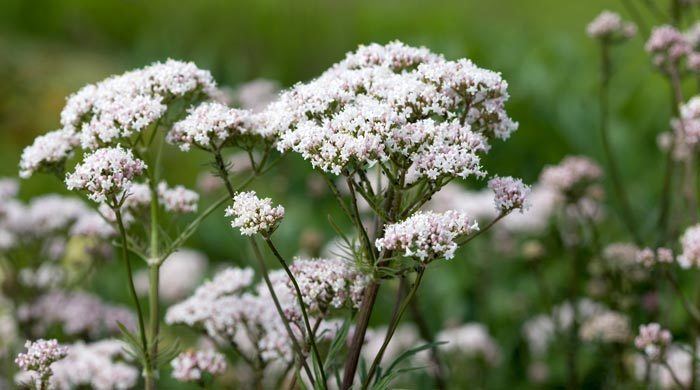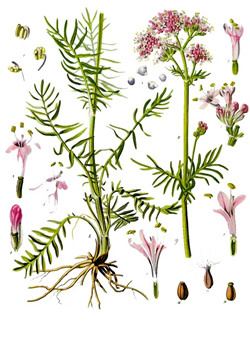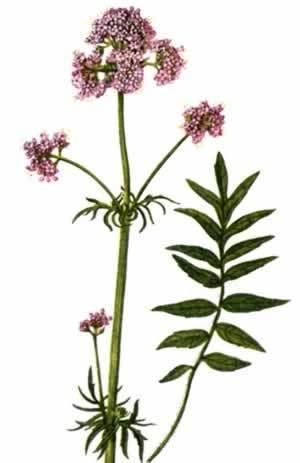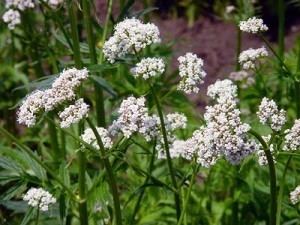Kingdom Plantae Family Caprifoliaceae Scientific name Valeriana officinalis Higher classification Common valerian | Order Dipsacales Genus Valeriana Rank Species | |
 | ||
Similar Perforate St John's‑wort, Lemon balm, Passion Flower, Common valerian, Purple passionflower | ||
Valerian (Valeriana officinalis, Caprifoliaceae) is a perennial flowering plant, with heads of sweetly scented pink or white flowers that bloom in the summer and can reach a height of 5 feet. Valerian flower extracts were used as a perfume in the 16th century.
Contents
- History
- Etymology
- Biochemical composition
- Mechanism of action
- Preparation
- Medicinal use
- Regulation
- Oral forms
- Adverse effects
- Effect on other organisms
- Floral symmetry
- Weed
- References

Native to Europe and parts of Asia, valerian has been introduced into North America. The flowers are frequently visited by many fly species, especially hoverflies of the genus Eristalis. It is consumed as food by the larvae of some Lepidoptera (butterfly and moth) species including the grey pug.
Other names used for this plant include garden valerian (to distinguish it from other Valeriana species), garden heliotrope (although not related to Heliotropium), setwall and all-heal (which is also used for plants in the genus Stachys). Red valerian, often grown in gardens, is also sometimes referred to as "valerian", but is a different species (Centranthus ruber) from the same family and not very closely related.

Crude extract of valerian root is sold as a dietary supplement in the form of capsules. Valerian root may have sedative and anxiolytic effects.

The amino acid valine is named after this plant.
History

Valerian has been used as a medicinal herb since at least the time of ancient Greece and Rome. Hippocrates described its properties, and Galen later prescribed it as a remedy for insomnia. In medieval Sweden, it was sometimes placed in the wedding clothes of the groom to ward off the "envy" of the elves. In the 16th century, the Anabaptist reformer Pilgram Marpeck prescribed valerian tea for a sick woman.

John Gerard's Herball states that his contemporaries found Valerian "excellent for those burdened and for such as be troubled with croup and other like convulsions, and also for those that are bruised with falls." He says that the dried root was valued as a medicine by the poor in the north of England and the south of Scotland, so that "no broth or pottage or physicall meats be worth anything if Setewale [Valerian] be not there."
The seventeenth century astrological botanist Nicholas Culpeper thought the plant was "under the influence of Mercury, and therefore hath a warming faculty." He recommended both herb and root, and said that "the root boiled with liquorice, raisons and aniseed is good for those troubled with cough. Also, it is of special value against the plague, the decoction thereof being drunk and the root smelled. The green herb being bruised and applied to the head taketh away pain and pricking thereof."
Etymology
The name of the herb is derived from the personal name Valeria and the Latin verb valere (to be strong, healthy).
Biochemical composition
Known compounds detected in valerian that may contribute to its method of action are:
Mechanism of action
Because of valerian's historical use as a sedative, antiseptic, anticonvulsant, migraine treatment, and pain reliever, most basic science research has been directed at the interaction of valerian constituents with the GABA receptor. Many studies remain inconclusive and all require clinical validation. The mechanism of action of valerian in general, and as a mild sedative in particular, has not been fully elucidated. However, some of the GABA-analogs, particularly valerenic acids as components of the essential oil along with other semivolatile sesquiterpenoids, generally are believed to have some affinity for the GABAA receptor, a class of receptors on which benzodiazepines are known to act. Valeric acid, which is responsible for the typical odor of mostly older valerian roots, does not have any sedative properties. Valeric acid is related to valproic acid, a widely prescribed anticonvulsant; valproic acid is a derivative of valeric acid.
Valerian also contains isovaltrate, which has been shown to be an inverse agonist for adenosine A1 receptor sites. This action likely does not contribute to the herb's possible sedative effects, which would be expected from an agonist, rather than an inverse agonist, at this particular binding site. Hydrophilic extractions of the herb commonly sold over the counter, however, probably do not contain significant amounts of isovaltrate. Valerenic acid in valerian stimulates serotonin receptors as a partial agonist, including 5-HT5A which is implicated in the sleep-wake cycle.
Preparation
The chief constituent of valerian is a yellowish-green to brownish-yellow oil which is present in the dried root, varying from 0.5 to 2.0%, though an average yield rarely exceeds 0.8%. This variation in quantity is partly explained by location; a dry, stony soil yields a root richer in oil than one that is moist and fertile. The volatile oils that form the active ingredient are extremely pungent, somewhat reminiscent of well-matured cheese. Though some people remain partial to the earthy scent, some may find it to be unpleasant, comparing the odor to that of unwashed feet. Valerian tea should not be prepared with boiling water, as this may drive off the lighter oils.
Medicinal use
Although valerian is a popular herbal medicine used for treating insomnia, there is no good evidence it is effective for this purpose, and there is some concern it may be harmful.
There is no good evidence that valerian is helpful in treating restless leg syndrome, or anxiety.
The European Medicines Agency (EMA) approved the claim that valerian can be used as a traditional herbal medicinal product in order to relieve mild symptoms of mental stress and to aid sleep. The EMA stated that there is a substantial body of evidence available that makes the traditional use of valerian plausible.
Regulation
In the United States, valerian extracts are sold as a nutritional supplement under the Dietary Supplement Health and Education Act of 1994.
Oral forms
Oral forms are available in both standardized and unstandardized forms. Standardized products may be preferable considering the wide variation of the chemicals in the dried root, as noted above. When standardized, it is done so as a percentage of valerenic acid or valeric acid.
Adverse effects
Because the compounds in valerian produce central nervous system depression, they should not be used with other depressants, such as ethanol, benzodiazepines, barbiturates, opiates, kava, or antihistamine drugs. Moreover, non-pregnant adult human hepatotoxicity has been associated with short-term use (i.e., a few days to several months) of herbal preparations containing valerian and Scutellaria (commonly called skullcap). Withdrawal after long-term use in a male has also been associated with benzodiazepine-like withdrawal symptoms, resulting in cardiac complications and delirium.
The very limited animal and human data do not allow a conclusion as to the safety of valerian during pregnancy. Moreover, as a natural, unregulated product, the concentration, contents, and presence of contaminants in valerian preparations cannot be easily determined. Because of this uncertainty and the potential for cytotoxicity in the fetus and hepatotoxicity in the mother, the product should be avoided during pregnancy.
Effect on other organisms
An unusual feature of valerian is that valerian root and leaves are a cat attractant similar to, and as safe as, catnip. Valerian contains the cat attractant actinidine. Cat attractants might mimic the odor of cat urine, which is caused by 3-mercapto-3-methylbutan-1-ol. Anecdotal reports claim that valerian is also attractive to rats—so much so that it had been used to bait traps. Stories describe the Pied Piper of Hamelin using both his pipes and valerian to attract rats. Research also shows that valerian root is the strongest chemoattractant of slime molds such as Physarum polycephalum.
Floral symmetry
Valerian is unusual in having flowers with "handedness", that is, having neither radial nor bilateral symmetry.
Weed
Valerian is considered an invasive species in many jurisdictions including Connecticut, US where it is officially banned and in New Brunswick, Canada where it is listed as a plant of concern.
